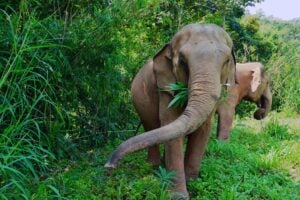
Places
Back where they belong
Nearly wiped out in Alberta in the 1800s, plains bison are making a historic return to Banff National Park
- 2148 words
- 9 minutes
Kids

As the largest land animal in Canada, the wood bison can be easily recognized by its large head, shaggy fur and pointed horns.
Common name: Wood bison
Scientific name: Bison bison athabascae
Type: Mammal
Diet: Herbivore
Group name: Herd
Average weight: 400 kilograms to 1,000 kilograms
Average length: 2 metres to 3.5 metres
COSEWIC Status: Special Concern
Despite their huge size, bison can run up to 55 kilometres per hour and are good swimmers.
The wood bison is the largest land mammal in North America, weighing up to 1,000 kilograms. Adults have dark brown coats, with long, shaggy fur on their shoulders and legs. They have large humps on their backs, and very large heads. They also have curving horns that point upward, and hair on the chin that resembles a beard. Wood bison begin to shed their winter coats as temperatures warm in the spring. By mid-summer, their coats will have been entirely replaced with new hair.
Wood bison can distinguish smells from up to three kilometres away. They have poor eyesight, but excellent hearing. During the mating season, from July to September, “bull roarings” can be heard for kilometres, day and night, as bulls challenge each other in rutting rituals.
The wood bison is closely related to North America’s other species of bison, the plains bison. Plains bison are slightly smaller, but tend to be more violent during the rut. Their vocalizations are different, and so is the length of the hair on their ribs (the plains bison has shorter hair in this area).
Wood bison mainly eat grasses and sedges, but also feed on lichens, shrubs, leaves and bark when available.
Wood bison are currently found in British Columbia, Alberta, Yukon and Northwest Territories. They are also present in Manitoba, although this is outside the species’ historical range. They live in boreal and aspen forests, where they often forage in open meadows, particularly during the winter. Some populations of wood bison prefer willow savannas in the summer and winter months, and open forests in the fall.
Are you passionate about Canadian geography?
You can support Canadian Geographic in 3 ways:

Places
Nearly wiped out in Alberta in the 1800s, plains bison are making a historic return to Banff National Park

Wildlife
By understanding why animals do what they do, we can better protect them while making people care

Travel
From South African penguins and Canadian bears to Australian wombats and Bolivian pumas, Robin Esrock introduces inspiring wildlife sanctuaries where volunteers make all the difference

Wildlife
The wood bison population is recovering, thanks in part to a 1957 discovery